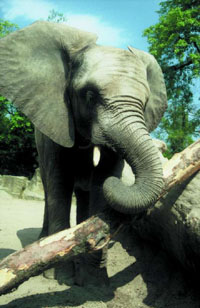Animals can be faster than bullet and stronger than locomotive
Just in time for the release of the new movie Superman Returns, National Geographic News takes a look at super animals that are "faster than a speeding bullet, more powerful than a locomotive, and able to leap tall buildings in a single bound." It’s not a joke. It is our Mother Nature that gave these animals such strength.

Speedsters
With a cruising speed of about 50 miles (80 kilometers) an hour and a maximum velocity of 200 miles (322 kilometers) an hour while dive-bombing prey, the peregrine falcon flies with real-world superpower speed.
The crow-size peregrine falcon achieves its greatest speed during the "stoop"—the technical term for its dive-bombing maneuver.
The raptor folds its wings, brings its talons forward, and careens toward the outstretched wings of an unsuspecting bird flying below.
The midair impact kills the prey, which the falcon immediately snares with its talons and flies away to eat, according the U.S. Fish and Wildlife Service.
The peregrine falcon's speed is necessary for the raptor's survival—the bird catches almost all its food on the stoop.
While the peregrine falcon is nature's speeding bullet of the skies, the cheetah is the fastest animal on land.
Scientists have clocked the big cat running up to 70 miles (113 kilometers) an hour for short 200-yard (183-meter) bursts.
Cheetahs use their speed to outrun their prey, which includes such fleet-footed creatures as gazelles and wildebeests.
Sailfish—swimming at a blazing 68 miles (109 kilometers) an hour—take the prize for fastest in the water, say experts at the Smithsonian Institution's National Zoo in Washington, D.C.
Powerful fins propel the streamlined fish toward meals of smaller fish and squid—and away from hungry sharks.
While super-sprinting is certainly a trait to admire, the Arctic tern is the high-endurance bird that just keeps on trucking.
According to WWF, the international conservation organization, the 10.6-ounce (300-gram) bird makes a 21,750-mile (35,000-kilometer) round-trip journey each year to the Antarctic so it can enjoy summer's bountiful food at both Poles.
Locomotive Strength
In terms of weightlifting and tugging strength, the African elephant impresses scientists with the strength of its trunk.
Packed with hundreds of muscles, the trunk alone can lift 600 pounds (270 kilograms), according to the University of Michigan Museum of Zoology's Animal Diversity Web site.
"Elephants do amazing things with their trunks," said Philip Myers, a zoologist who directs the museum's online database.
But when you look at the amount of weight they can lift in proportion to their body size, elephants are wimps compared to rhinoceros beetles.
So named because of a horn-shape appendage on its head, the 0.7-ounce (20-gram) beetle can lift 850 times its own weight, according to the Smithsonian. Elephants, by contrast, can only lift about a quarter of their weight.
Scientists believe the beetles use this strength to plow through the woody debris that covers their tropical jungle habitat.
Great Leapers
The tiny spittlebug, or froghopper, leaped into the scientific spotlight in a July 2003 issue of the journal Nature.
The 0.2-inch-long (6-millimeter-long) insect can catapult itself 28 inches (70 centimeters) into the air. According to scientists, the feat is equivalent to a human leaping over a 690-foot-tall (210-meter-tall) skyscraper in a single bound.
The flea is probably the froghoppers' runner-up.
The tiny insect can jump 7 inches (18 centimeters) high and 13 inches (33 centimeters) long, according to the Insecta Inspecta World Web site. That's the equivalent of a human long-jumping 450 feet (137 meters).
The San Diego Zoo's Rieches points to the impala, an African antelope, as another animal worthy of recognition.
It regularly cruises at 35 to 45 miles (56 to 72 kilometers) an hour and can jump almost 12 feet (3.7 meters) high in the air.
And when they get a running start, "they can cover almost 30 feet [9.1 meters] in distance," he said.
Source: The National Geographic
Prepared by Alexander Timoshik
Pravda.ru
Discuss this article on Pravda.ru English Forum
Subscribe to Pravda.Ru Telegram channel, Facebook, RSS!


